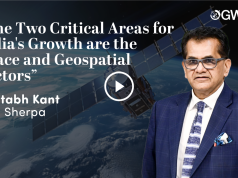Tech integration, data sharing, and localization to be major drivers of growth
The widespread utility of geospatial data and insights across sectors is increasing at an exponential pace, redefining sectors, and unveiling newer streams of investment.
According to estimates, the Indian geospatial sector would be worth INR 63,000 Crores by 2030. However, Anup Jindal, CEO, RMSI earnestly believes that it has the potential to exceed this figure, clocking a higher growth.
“There’s a direct co-relation between the growth trajectory of geospatial and India’s overall growth, and it will continue”, he adds.
At the Frontier
As India looks forward to becoming a robust and dynamic innovation hub, geospatial would be a key driver of economic transformation.
Cloud, AI, and ML would be other game-changers powering growth. Be it razor-sharp customized analytics, or building immersive solutions, there is a growing integration of frontier tech with geospatial.
“With AI and ML, the value chain of geospatial is moving up. For planning and visualization, things are moving towards 3D Models and eventually to Digital Twins”, says Sreeramam GV, CEO, NeoGeoInfo Technologies.
Data Access
While there is plethora of data available from different sources, go-to sources and right inventories are either missing or hard to access. Unrestricted data access, standardization, and interoperability are crucial for developing cutting-edge applications and solutions that exceed customer expectations.
“Data access and availability has been one of the challenges. Another is turning data into solutions to solve problems. There is a need for more data-sharing and collaboration”, states Rajesh C Mathur, Advisor, Esri India.
“A lot of data-fusion and amalgamation from a problem-solving perspective is expected. Triad of cost, turnaround time, and coverage is where space data is unbeatable”, believes Prateep Basu, CEO, SatSure.
“Traditionally, EO has been a much smaller part of geospatial, however with more sensor varities the dynamic is changing”, he adds.
Need to Localize
The impetus towards local capacity building is at the core of the government’s push towards indigenous R&D, critical for turning India into an innovation powerhouse.
“Trimble is actively involved in localization. We can ‘Make in India’ for the world as well. Just like IT evolved from services to solutions, geospatial needs to follow the same trajectory, but within the next five years”, says Rajan Aiyer, Managing Director, Trimble India.
“Cross-collaboration and scalability are also crucial. While India is known for software, there is a need to focus more on hardware as well, so that the brand value of the ‘Made in India’ mark increases”, he adds.





